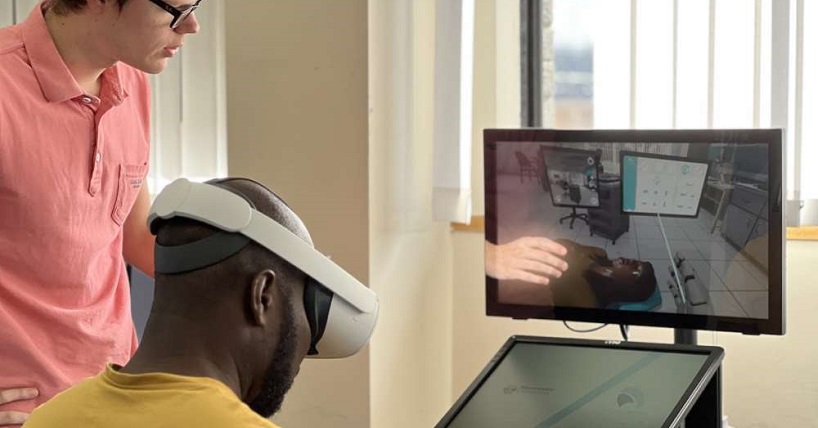Powering the NHS
Education leaders sound warning on future of healthcare
Published on: 31 October 2023
With 112,000 vacancies across the health workforce, a five-point plan for healthcare education and training has been proposed to turn ambitions into a reality.
The Government’s NHS Long Term Workforce Plan ((LTWP) aims to ramp up training, double medical school spots and increase nursing and midwifery training places by 80%.
However, the ambitious plans to strengthen the NHS can only be achieved if significant changes are made to healthcare education and training now, warns Universities UK (UUK).
And Newcastle University is getting a head start to protect the NHS as its School of Medicine is already contributing towards the delivery of the plan with innovative research and training well underway.

‘Train, retain and reform’
The NHS Long Term Workforce Plan (LTWP) was published by the UK Government in June this year, with the aim of addressing NHS staffing shortages across three key pillars: train, retain and reform.
With opposition parties also signalling a commitment to invest in healthcare professionals over the coming years, now is a pivotal moment to secure the future of the NHS in England. Concern about the NHS is now the public’s second biggest worry according to recent Ipsos research, while research also shows people’s top priorities for the health service are expanding and supporting the NHS workforce.
The plan’s success, however, hinges on a joint endeavour between education and healthcare providers, with universities both educating the next generation of healthcare professionals, and driving innovation that can improve health outcomes.
UUK says a number of challenges still need to be overcome if the LTWP is to meet its objectives and prevent the talent pipeline from drying up. This includes a need for higher education to expand health education capacity, and for a culture shift to take place within the NHS to place more value on students and educators.
UUK is setting out a five-point plan to meet the objectives of the LTWP and support future and existing talent, including in the North East:
- Boosting student recruitment: With applications to nursing, midwifery and allied health professional (AHP) courses declining, UUK is calling on government for a major national recruitment campaign produced in partnership with universities, colleges, schools and the NHS.
- Increasing the numbers of educators: Shortages in clinical academic and teaching staff is a limiting factor for expansion. Currently 50% of healthcare educators are over 50 years old. An urgent review is needed of educator roles and careers, to attract different kinds of staff into roles. A cultural shift is also needed within the NHS towards students and educators to make space for them and ensure they feel valued.
- Investing in new facilities and infrastructure including new technologies: Expanding capacity to boost learner numbers will require extending university and college facilities as well as opening new schools. This means additional teaching space, flexible space and exam facilities. There are opportunities to extend capacity through learning technology such as immersive environments, simulation, and robotics, all of which requires capital investment.
- Increasing placement capacity: The availability, quality and distribution of placements must continue to be a focus for government, the NHS and universities and colleges. Closer working between the NHS in England and universities is required to diversify placement capacity in community settings such as care homes and schools, as well as increasing hospital placements.
- Improving learner experience and reducing attrition: Many health courses experience high rates of attrition that continue into early careers. Common factors include cost of living pressures and travel and accommodation expenses. Additional wellbeing and mental health support, more regular check-ins, better coaching, and mentoring support is necessary. Financial support should be inflation linked and students from low-income families should receive more help.
Professor Chris Day, Vice-Chancellor and President of Newcastle University, said: “We fully support the recommendations made by Universities UK to transform healthcare education in this country.
“With the right conditions, universities like ours can provide the talent, expertise and technology needed for the NHS to thrive for decades to come.”
Higher education’s role in the delivery of the LTWP includes innovative approaches to education and training to identify future skills gaps, recruiting from more diverse communities, introducing new routes into the profession, new clinical roles and advances in technology.
Boosting the number of staff employed by the NHS in England from approximately 1.5 million in 2022 to around 2.4 million in 2036–37 is also a key ambition. By 2036-37, the objective is that almost half (49%) of public sector workers will work for the NHS, comprising one in 11 (9%) of all workers in England, compared with one in 17 (6%) in 2021–22.
To develop a well-staffed and efficient NHS, the UK Government must work closely with universities to fund the plan over the next 15 years, spanning both general elections and spending reviews.
Professor Alistair Fitt, Universities UK’s health policy lead, and Vice-Chancellor of Oxford Brookes University, said: “With political consensus on the need to significantly increase the number of healthcare professionals over the coming years, now is a pivotal moment to protect the future of the NHS in England.
“To develop a well-staffed and efficient NHS, the UK Government must work closely with universities to fund the plan over the next 15 years, spanning general elections and spending reviews. We must take bold decisions to ensure the conditions are right for universities to train staff adequately, including on funding and capital investment, staffing and student recruitment.
“For the government’s ambitions for our national health service to come to fruition requires a step change in healthcare education.”

Training future dentists
Newcastle University is a great example of how universities are already key to contributing to delivering the Government’s plan.
In training the next generation of dentists and dental therapists, the University's School of Dental Sciences uses virtual reality (VR) enabled haptic dental simulators.
This innovation uses the Virteasy V2 Dental Simulator powered by the Epic Games’ Unreal Engine, which brings lifelike simulation to clinical scenarios. The haptic element, which relates to the sense of touch and calculates the force required for users to feel the object, provides real-time feedback of cutting through different dental tissue and is capable of replicating dental implant placement.
The haptic suite will be a core part of Newcastle’s new £5.5m dental clinical skills facilities, which will be opening in 2024. Haptic simulation training supplements the traditional approach by providing unlimited opportunities for procedural rehearsal and training, while enhancing patient safety.




